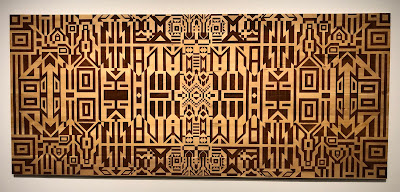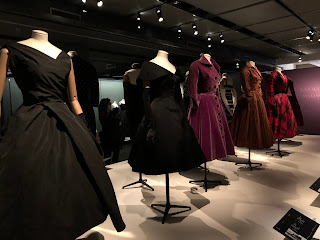The Musée d'Art Contemporaine is currently staging a show of its recent acquisitions. Des Horizons d'Attente features the work of 21 Montreal-based artists. There are no traditional paintings in the collection. Instead, visitors are treated to some novel uses of materials like cloth, paper, wood and plastic. There is a particular emphasis on aboriginal issues and imagery.
 |
| Facade de recueillement, 2016-2017 [Contemplation Facade] Myriam Dion Japanese paper cut with X-acto knife, graphite |
 |
| Facade de recueillement, 2016-2017 [Contemplation Facade] Myriam Dion Japanese paper cut with X-acto knife, graphite |
 |
| Essai d'aplanissement entre les mondes, 1999-2020 [Levelling Trial Between the Worlds] Pierre Bourgault Installation: shore mud on wood and ink-jet print on paper |
 |
| Essai d'aplanissement entre les mondes, (detail) 1999-2020 [Levelling Trial Between the Worlds] Pierre Bourgault Installation: shore mud on wood and ink-jet print on paper |
 |
| water song [Kinosipi] 2019 Hannah Claus Installation, digital print on Jetview© film, thread, PVA glue, acrylic |
 |
| water song [Kinosipi] 2019 (detail) Hannah Claus Installation, digital print on Jetview© film, thread, PVA glue, acrylic |
 |
| Lot #X - Front de la rivière Désert, 2018 [Lot #X - Desert River Front] Caroline Monnet Pyrography on wood |
"Using pyrography, a network of geometric motifs inspired by Indigenous graphic traditions is outlined on this large wooden support made of white cedar..., a tree native to Canada and considered sacred by First Nations. The mention of the term 'Lot # X' in the title, the horizontal cuts and the arrow symbols in the composition suggest the lots of land laid out following the forced uprooting of Indigenous communities over the centuries. Like a metaphorical map with a modern pictorial look, this work gives material form, through wood burning, to the confiscation of Indigenous lands and the scars it has left on Indigenous peoples".
The exhibition continues until September 19, 2021.
















